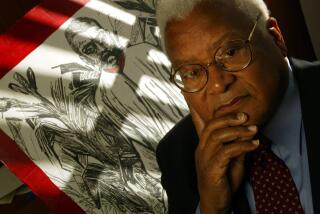Quiet Freedom Fighter Makes a Last Journey
MONTGOMERY, Ala. â Inside her massive, lustrous casket, drawn by horses with trembling ostrich feathers on their heads, Rosa Parks lay in the outfit she asked to be buried in: the white uniform she wore as a church deaconess, which she lovingly hand-washed every Sunday after services.
It was typical of a woman who lived so modestly that âwe had to force her to take a new dress,â said a cousin, Nina Donaldson, 48, after viewing Parksâ body at Montgomeryâs St. Paul African American Episcopal Church on Saturday. âMy heart just really went out. She was just such a humble person.â
On a sunlit afternoon in Montgomery, thousands of people lined up for a last look at the quiet seamstress whose act of defiance -- she refused to yield her seat on a city bus to a white passenger -- launched the civil rights movement.
Younger mourners emerged smiling, uplifted by the experience of being near Parks. Older ones were overcome by a rush of memory. Ivery Giles, 80, worked several doors down from Parks in 1955 and was seated behind her on the bus that afternoon. From her seat, Giles watched as the driver grew angrier. Parks, she said, betrayed no emotion but that of patience.
âYou never know whatâs in a person,â said Giles. âIt went up in flames, just like putting wood on a fire, pouring a little oil on it. It started a fire, sure did.â
Montgomery is the first of several viewings of Parks, who died Oct. 24 at age 92. Today and Monday she will be the first woman and the second African American to lie in honor in the Rotunda of the Capitol in Washington, an accolade usually reserved for presidents and military commanders. She will then be on view in Detroit, where she had lived since 1957, until her funeral, which is scheduled for Wednesday.
The viewing in Montgomery had a special poignancy. In 1955, on the day she was tried for her civil disobedience, more than 5,000 people packed into the Holt Street Baptist Church to hear a speech by, among others, a little-known 26-year-old minister named Martin Luther King Jr.
For the next 381 days, blacks in Montgomery boycotted the city bus system. Mourners, now elderly, remembered the elation of the days they spent walking and the way anger over years of indignities began to well up.
âWe -- I say we, I mean blacks -- we were treated as if we were a bug or something that had no feelings,â said Mabel Smith, 85, a retired schoolteacher. âI couldnât say an animal -- a cat or a puppy -- because we love animals. I mean something you would kill and think nothing about it.â
In 1956, a lawsuit filed by Parksâ lawyer made its way to the Supreme Court, which declared segregation of city buses unconstitutional. Soon afterward, Parks and her husband left Alabama, exhausted by threats to their safety and an inability to find work. They had also been let down by the civil rights community, who âdid not give her the recognition she deserved,â said Lamar Higgins, 47, a member of the board of trustees of Troy University in Alabama.
âThe civil rights movement was dominated by men,â Higgins said. âIt was men who made speeches and got on camera.â
On Saturday, though, people drove into Montgomery from all over the South and stood in a line that snaked off the church grounds and across the parking lot, across the street, where a replica of the original bus was parked. The crowd included the actress Cicely Tyson, NAACP President Bruce S. Gordon, the Rev. Jesse Jackson and the Rev. Al Sharpton. Tyson portrayed Parksâ mother in the 2002 television movie âThe Rosa Parks Story.â
Lonnie McCauley, a great-nephew of Parksâ from Detroit, stood outside the sanctuary, overjoyed. His aunt rarely spoke about the bus boycott, even to family members, unless they pressed her, he said, and then she would mention only âbits and pieces.â He had expected to find a handful of mourners in Montgomery.
âItâs a beautiful sight to see all these people,â said McCauley, 31.
Among them was Ethel Robinson, 94, who took sewing lessons from Parks and had a particular tenderness for her; when a student cut a pattern wrong, Parks âwouldnât expose you in front of the classâ but, instead, would call private conferences at the end of class. She was, Robinson said, âas humble as a dove.â
Alphonsa Perry, 61, recalled a different kind of lesson. Perry was part of an NAACP youth organization that Parks sponsored, and during those tense years, when the young men in the group struggled with their fear of white people, Parks âtaught us not to be afraid,â Perry said.
That sense of serenity and courage seemed to intensify in the summer of 1955, when Parks attended a workshop on school desegregation at the Highlander Folk School in Monteagle, Tenn., Perry said.
âI think at that point in her life, she lost fear,â he said.
Parksâ long history of civil rights activism before the bus boycott tends to be âneutralizedâ in the retelling of her story, Jackson said.
More than 10 years before the boycott, she was elected secretary of the Montgomery chapter of the National Assn. for the Advancement of Colored People, an organization that was reviled by many Southern whites.
Parks also had taken note of the case of a 15-year-old black girl, Claudette Colvin, who was arrested for refusing to yield a seat, and discussed its potential as a desegregation test case.
Jackson said Parks was irritated by the suggestion that she refused to yield her seat simply because she was exhausted.
She spoke, instead, of her outrage over the lynching of Emmett Till, a black teenager who was murdered and mutilated by white men in Mississippi during the summer of 1954.
âShe said, âMy feet were not tired. I was violated,â â Jackson said. âShe was a freedom fighter. She wasnât just a seamstress. She didnât get arrested for sewing.â
Still, on Rosa Parksâ last journey through Montgomery, the sense of wonder persisted that such a soft-spoken person sent the Jim Crow South into turmoil.
One after another, passing through the church until late into the evening, acquaintances spoke of Parksâ modesty, her thoughtfulness. To the casual observer, she seemed to have no ego at all, said Smith, 85.
âNo one ever thought she would be the one to do it,â she said. âThey said, âRosa? No, not Rosa.â â
More to Read
Sign up for The Wild
Weâll help you find the best places to hike, bike and run, as well as the perfect silent spots for meditation and yoga.
You may occasionally receive promotional content from the Los Angeles Times.






